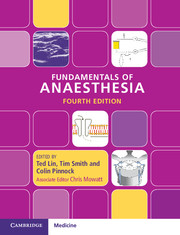Book contents
- Fundamentals of Anaesthesia
- Fundamentals of Anaesthesia
- Copyright page
- Dedication
- Contents
- Contributors
- Preface to the first edition
- Preface to the second edition
- Preface to the third edition
- Preface to the fourth edition
- Acknowledgements
- Abbreviations
- Section 1 Clinical anaesthesia
- Chapter 1 Preoperative management
- Chapter 2 Conduct of anaesthesia
- Chapter 3 Intraoperative management
- Chapter 4 Postoperative management
- Chapter 5 Special patient circumstances
- Chapter 6 The surgical insult
- Chapter 7 Regional anaesthesia
- Chapter 8 Principles of resuscitation
- Chapter 9 Major trauma
- Section 2 Physiology
- Section 3 Pharmacology
- Section 4 Physics and clinical measurement
- Index
- References
Chapter 4 - Postoperative management
from Section 1 - Clinical anaesthesia
Published online by Cambridge University Press: 19 January 2017
- Fundamentals of Anaesthesia
- Fundamentals of Anaesthesia
- Copyright page
- Dedication
- Contents
- Contributors
- Preface to the first edition
- Preface to the second edition
- Preface to the third edition
- Preface to the fourth edition
- Acknowledgements
- Abbreviations
- Section 1 Clinical anaesthesia
- Chapter 1 Preoperative management
- Chapter 2 Conduct of anaesthesia
- Chapter 3 Intraoperative management
- Chapter 4 Postoperative management
- Chapter 5 Special patient circumstances
- Chapter 6 The surgical insult
- Chapter 7 Regional anaesthesia
- Chapter 8 Principles of resuscitation
- Chapter 9 Major trauma
- Section 2 Physiology
- Section 3 Pharmacology
- Section 4 Physics and clinical measurement
- Index
- References
Summary
Emergence from anaesthesia, although usually uneventful, can be associated with major morbidity. In the immediate postoperative period, patients are at risk from respiratory and cardiovascular complications, which account for approximately 70% and 20% of critical recovery room incidents respectively. The unconscious patient may develop upper airway obstruction or inadequate ventilation with subsequent hypoxaemia and hypercapnia, and is at increased risk of aspiration because of the absence of the protective airway reflexes. Ongoing blood loss and residual drug effects may compound cardiovascular compromise. The importance of observation and early intervention during this period has been recognised for many years. Hazards may be reduced by the provision of adequate postoperative recovery facilities along with fully trained staff. Guidelines for postoperative care are provided by the Royal College of Anaesthetists as part of the Guidelines for the Provision of Anaesthetic Services, 2014.
- Type
- Chapter
- Information
- Fundamentals of Anaesthesia , pp. 57 - 78Publisher: Cambridge University PressPrint publication year: 2016



